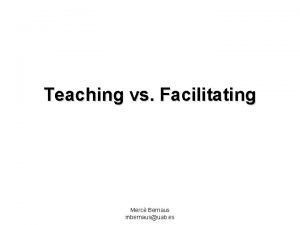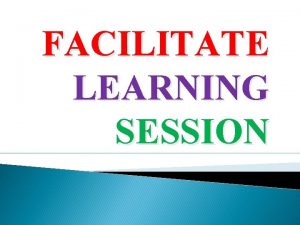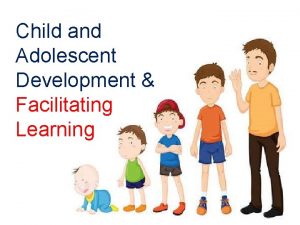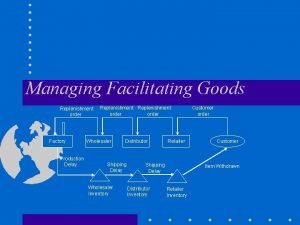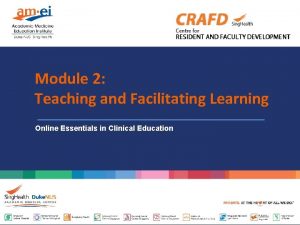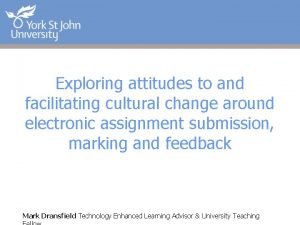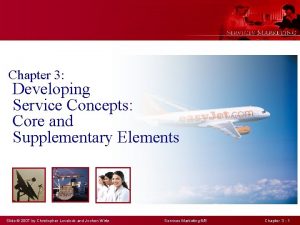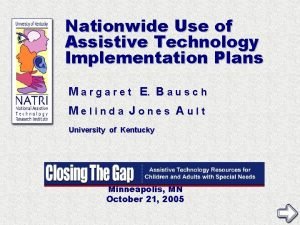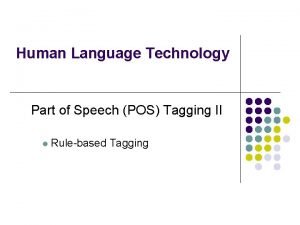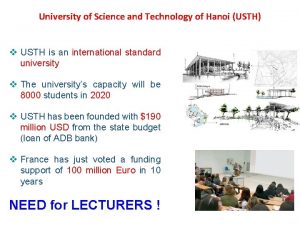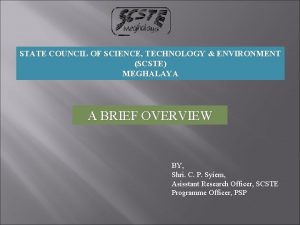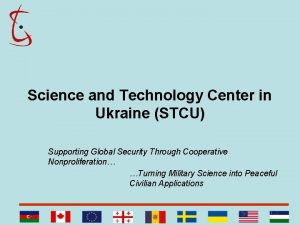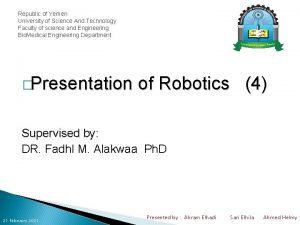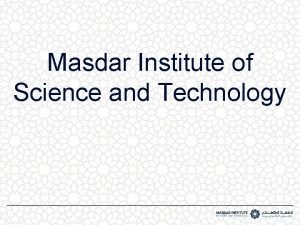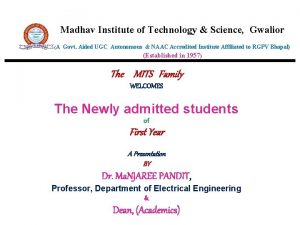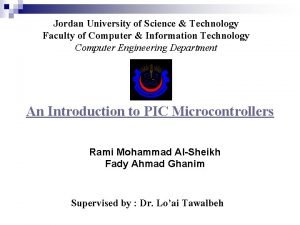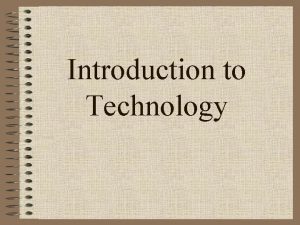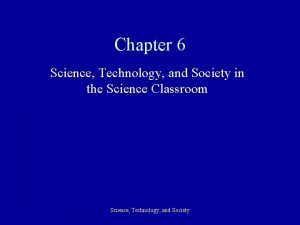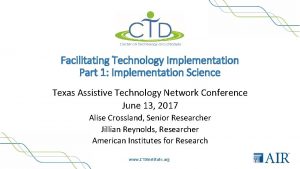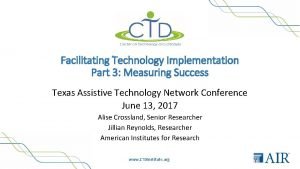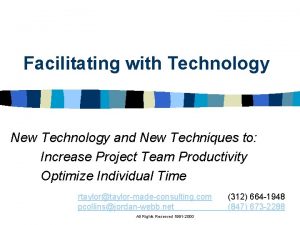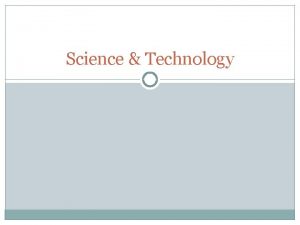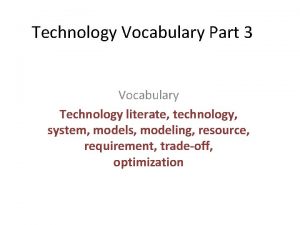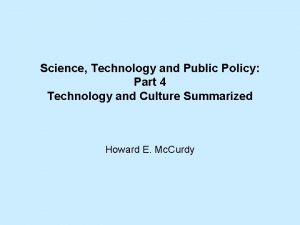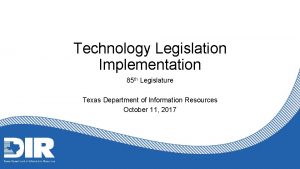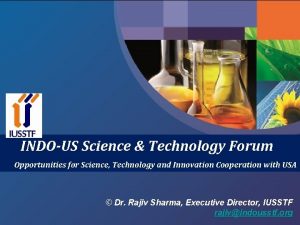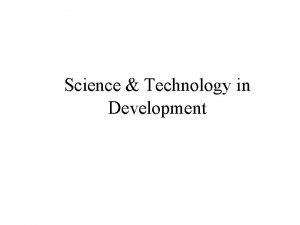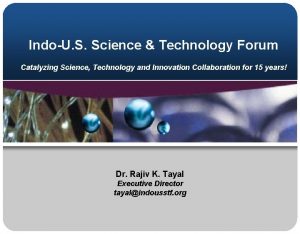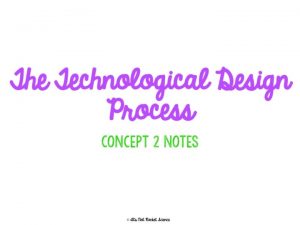Facilitating Technology Implementation Part 1 Implementation Science Texas






































- Slides: 38

Facilitating Technology Implementation Part 1: Implementation Science Texas Assistive Technology Network Conference June 13, 2017 Alise Crossland, Senior Researcher Jillian Reynolds, Researcher American Institutes for Research www. CTDInstitute. org

Making It Happen Recommendations from Implementation Science Research www. CTDInstitute. org

Best Practice Recommendations Work as a Team Enhance Your Vision & Set Goals Gather Data to Drive Decision Making Define Technology Budget www. CTDInstitute. org Plan PD Opportunities Provide Access to Technology & Support

Questions to Guide Implementation Planning • Who is (or should be) included on your Leadership Team? • What are your short- and long-term goals for integrating technology to ensure improved outcomes for SWDs? • How do you make decisions about allocation of, and access to, technology? • How do you budget for technology purchases as well as ongoing maintenance and upgrade costs? • How can you support teachers as they integrate technology? • What kinds of PD can you provide to support teachers in their learning about how to integrate technology throughout instruction? www. CTDInstitute. org

The Process is Critical to Success • Moving toward active technology use requires an implementation plan that: • Clearly articulates your vision • Sets short- and long-term goals • Identifies action steps to reach goals • Using the implementation plan: • Devise your strategy • Evaluate your progress • Make changes to ensure you achieve stated outcomes www. CTDInstitute. org

Getting to Improved Outcomes Effective Innovations Effective Implementation www. CTDInstitute. org Positive Outcomes

Roadmap for Technology Implementation Get Ready Get Set Budget for Technology Support Your Teachers Assess readiness Review data Develop tech inventory Plan PD Establish communication plans Enhance mission Define budget Establish support processes Set goals www. CTDInstitute. org

To plan successfully, you must recognize where you are and where you want to go to accomplish your goals. www. CTDInstitute. org

Assess Readiness Action Steps: • Assess readiness of school/district for change • Identify current technology approach (BYOD, 1 -1, rolling laptop carts, etc. ) • Gauge resources (staff, money, space) currently invested in technology • Gather information on staff and student perceptions of current technology use in the classroom • Use information gathered to guide decisions and ensure that the team addresses unique needs and builds on unique strengths www. CTDInstitute. org

Effective district and/or school-wide technology implementation requires a strong Leadership Team. www. CTDInstitute. org

Work as a Team Action Steps: • Select and finalize members of the Leadership Team • Plan outreach to stakeholders and build a community • Establish a schedule and routine to ensure effective communication www. CTDInstitute. org

Schools that create a vision and set goals for technology implementation are more likely to be successful than those where implementation is driven by the sudden availability of funds. www. CTDInstitute. org

Enhance Your Vision and Set Goals Action Steps: • Read vision statements and goals written by districts around the nation • Ensure that your vision and goals describe how technology will support student learning • Record and share your work with staff and parents www. CTDInstitute. org

Harness the power of data to identify areas for school improvement, determine goals, plan professional development, and transform student learning. www. CTDInstitute. org

Gather Data to Drive Decision Making Action Steps: • Gather relevant extant student, teacher, and school data • Analyze data and determine if additional data should be collected to address priorities • Collect additional data if necessary and use data to inform professional development planning and implementation activities www. CTDInstitute. org

In budgeting for technology, consider alternatives to funding and plan not only for initial costs but also for long-term maintenance and replacement costs to facilitate sustainability. www. CTDInstitute. org

Define Technology Budget Action Steps: • Review your existing technology budgets (include AT) • Determine costs for upgrading infrastructure and purchasing new devices • Identify funds to meet short- and long-term goals • Develop a multiyear plan to support sustainability of technology costs • Review and refine your budget as needed www. CTDInstitute. org

Build capacity to use and integrate technology by fostering a school culture that supports continuous learning. Give staff concrete strategies to integrate technology into instruction and the confidence to use those strategies. www. CTDInstitute. org

Plan PD Opportunities Action Steps: • • • Refine goals and set focus Define modes of professional learning activities Determine frequency of professional learning opportunities Set concrete, actionable goals Reflect and refine professional learning plan www. CTDInstitute. org

Technology use and implementation requires continuous support and a systemic process through which teachers can access assistance when experiencing technical difficulties with the technology. www. CTDInstitute. org

Provide Access to Technology and Support Action Steps: • Complete/revise your technology inventory • Plan how you will provide increased technology access • Determine how teachers will access support when experiencing technical difficulties and communicate this information to all staff www. CTDInstitute. org

Start Small! • Focus on concrete short-term goals and small, early successes • These small successes can build excitement for the initiative • Leadership teams that start small tend to enjoy greater long-term success • Change is a multi-year effort and can feel uncomfortable or unfamiliar • Success early in the process increases confidence and generates momentum In what ways are you building success in your school or district? www. CTDInstitute. org

Roadblocks to Success Silos in Education are a Common Roadblock in Technology Implementation www. CTDInstitute. org

The Challenge: Connecting AT and IT • Leveraging technology to meet the needs of diverse learners • Streamlining resources, training, funding streams • Aligning initiatives and shared priorities amongst different agencies, departments • Creating integrated systems to ensure that best practices and high quality resources benefit ALL of your students www. CTDInstitute. org

Where Are the Silos in Education? Special Education English as Second Language Title I Gifted/ Talented www. CTDInstitute. org Assistive Technology

Silos Hinder Implementation and Innovation • • Competing priorities Lack of clear vision or direction Isolation of staff Gaps in services Redundancies Ineffective and/or inefficient use of resources Good ideas and best practices don’t spread www. CTDInstitute. org

www. CTDInstitute. org

Address Silos by Building Bridges • Break down silos and build bridges between technology teams, AT specialists, special and general education, to leverage technology to meet the needs of students with disabilities (SWDs) • Establish systems for collaboration between general and special education around the effective use of assistive and educational technology • Build a shared vision of transformative learning enabled by technology for ALL students www. CTDInstitute. org

Shared Values to Build the Bridge • Needs of students and families cross agencies and departments “We are in this together. ” • Collaborative relationships offer opportunities to work together more effectively and efficiently • Building on successful initiatives provides opportunities for collaboration and growth www. CTDInstitute. org

Steps to Break Down Silos • Build your collaborative team – assistive technology, educational/instructional technology, special education, general education, curriculum specialists, assessment, digital media/library • Take stock – Have there been previous efforts to do this work? What worked? What didn’t? • Define the problem – Develop shared definitions of problems and challenges, shared vision for technology • Communicate the vision – communicate vision for aligning tech initiatives with key stakeholders; gain buy-in through clear communication of shared vision www. CTDInstitute. org

Quick Poll • Are you part of a cross departmental team for technology planning? Is anyone from your department involved? • What is your biggest challenge in leveraging technology for teaching and learning? • If you could change one thing, what would it look like? www. CTDInstitute. org

Build Your Collaborative Team Superintendents School board members Special Education Technology Personnel Specialists Lead teachers Principals Parents Team www. CTDInstitute. org Community Members

Take Stock Review the current technology landscape in your district and/or school to guide decision-making, planning, and implementation. • • • What technology tools are available in our district/school? How are teachers currently using these tools? What more can be done to maximize use of these tools? Which technology options are working? How do you know? What other approaches could meet your needs? What are the benefits and challenges? www. CTDInstitute. org

Define the Problem and Vision • Agreeing that technology supports student learning is easy; the hard part is to define what this actually looks like in daily instruction • Generating a shared vision is a critical step in creating your technology implementation plan • Without a clear vision of what you aim to achieve, it is difficult to plan short- and long-term goals The absence of a clear vision is one of the main reasons that technology initiatives fail www. CTDInstitute. org

Developing/Enhancing Your Vision • Reflect on the current vision and adapt to include use of technology-supported evidence-based strategies • Vision should be clear and concise and address learning outcomes for all student subgroups, including students with disabilities • Vision should include language addressing accessibility and equity in accessing technology resources • Gather ideas from teachers, school board members, and parents throughout the process to build buy-in • Foster shared commitment to achieving the vision by sharing with staff, parents, and students www. CTDInstitute. org

Example Vision Statement The members of the Task Force share a common vision, which is the desire to break down the historically perceived silos of special education and general education, and employ all of the resources that are available to improve the service delivery and effectiveness of programs for all students, including students who are eligible for special education services. The Task Force hopes to advance this vision by removing the “special education” labels that have been traditionally used to distinguish students, staff, and resources within special services programs or departments to emphasize that all children are an equal part of the school community. Instead of “special education students” and “general education students, ” all should be recognized as “students. ” - New Jersey Task Force on Improving Special Education for Public School Students www. CTDInstitute. org

Communicate the Vision • Mobilize people and resources by developing an outreach and marketing plan to engage external stakeholders • Develop a communication plan to facilitate ongoing progress updates to all stakeholders • Consider strategies that increase team effectiveness: • • Post announcements on the district and school websites Maintain continuous communication with school staff through regular emails Schedule face-to-face meetings with core leadership team members to monitor progress and assign tasks Provide regular updates to parents and community stakeholders www. CTDInstitute. org

Discussion • Is your school/district taking steps to address silos between general and special education, particularly in technology? • Is there currently a shared vision for the use of technology in general education and special education in your school or district? • Do priorities in educational/instructional technology align with those in special education/assistive technology? Does technology funding cross silos? www. CTDInstitute. org
 Think central k5
Think central k5 Maths is my favourite subject
Maths is my favourite subject Teaching vs facilitating
Teaching vs facilitating Facilitate training session
Facilitate training session Scaffold and fade-away technique
Scaffold and fade-away technique Facilitating goods
Facilitating goods Merchant wholesalers
Merchant wholesalers Channelparticipants
Channelparticipants Importance of marketing channel
Importance of marketing channel Facilitating learning module 2
Facilitating learning module 2 What are the factors affecting communication
What are the factors affecting communication Facilitating cultural change
Facilitating cultural change Lovelock flower of service model
Lovelock flower of service model Fda 513g
Fda 513g Assistive technology implementation plan sample
Assistive technology implementation plan sample Piney woods erosion
Piney woods erosion Part part whole addition
Part part whole addition Unit ratio definition
Unit ratio definition Part part whole
Part part whole Technical object description example
Technical object description example Cocktail bar parts
Cocktail bar parts The part of a shadow surrounding the darkest part
The part of a shadow surrounding the darkest part 미니탭 gage r&r 해석
미니탭 gage r&r 해석 Language and technology
Language and technology Earth science regents locating an epicenter
Earth science regents locating an epicenter Branches of astronomy
Branches of astronomy Hanoi university of science and technology vietnam
Hanoi university of science and technology vietnam Spike unist
Spike unist Scste meghalaya
Scste meghalaya Science and technology center in ukraine (stcu)
Science and technology center in ukraine (stcu) The university of science and technology yemen
The university of science and technology yemen Masdar institute of science and technology
Masdar institute of science and technology Madhav institute of technology and science
Madhav institute of technology and science Jordan university of science and technology
Jordan university of science and technology Jordan university of science and technology
Jordan university of science and technology Define science
Define science Natural science and technology grade 4 worksheets term 1
Natural science and technology grade 4 worksheets term 1 Science, technology and society module answer key
Science, technology and society module answer key Science adverb form
Science adverb form


